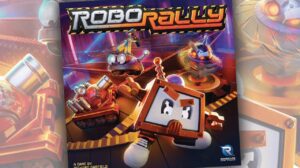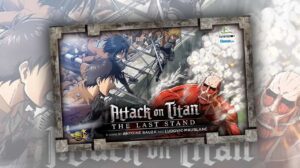Disclosure: Meeple Mountain received a free copy of this product in exchange for an honest, unbiased review. This review is not intended to be an endorsement.
Usually, I avoid talking about the artwork in a board game because trying to pass off judgment on a subjective matter often comes across as arrogant. I would also assume that anyone who has an interest in a board game, can see for themselves whether the game’s art style is for them. I know there is the cliché of “A picture is worth a thousand words,” but I have heard all of these words, twice. Yet Adventure Mart’s cover made me pause to observe the character designs and use of bright colors splashed over its box. It was a game that looked so pretty that I wondered if it had its own Instagram account.
Sure, the artwork can be an easy way to gather attraction, but themes and mechanisms are what really gets me to delve beyond the covers. In this one, it involves running a store for the typical role-playing adventurers…in a franchise convenience store? I have to admit, that’s a new one. Throw in the deckbuilder genre that I cannot say no to, and suddenly I find myself reviewing this game.
Based on the theme, it’s a good guess that you and your friends are store managers maintaining your slice of the corporate pie. You have five days to prove you are the best, and your performance is evaluated by your net worth, which consists of the value of your inventory, the fixtures, and liquid cash. If you are the highest, you are given a few sentences of praise by the suits, and everything goes well. Fail to achieve this goal, and you are on your way to the “Abyss” for additional training.
Each day starts with the Daily Bulletin, a yellow card that gives some random effect that premeditates the upcoming round. These cards will trigger special effects, such as Adventurers having some extra coin to spend or everyone drawing an additional Stock card. I’ll admit that when I first read this rule, I was skeptical because I have seen this type of system “work” with dubious results. After playing Adventure Mart a handful of times, I found them to be significant enough that I have paid attention to them to win, but not drastic enough to be a frustrating endeavor.

Managing The Grind
Your day-to-day activities will revolve around attracting adventurers, buying cards, and using card abilities. Using your card abilities is as straightforward as it sounds. Some cards will have the “Use” keyword and denote the usual rule-breaking text for something cool and interesting then discarding the card. While this does sound plain vanilla, the twist here is that any card you play does not replenish your hand. Unlike other deckbuilders, you do one action at a time instead of dumping your entire hand on the table. It also means the clichés of silly combos and complicated turns have evolved into vital decision-making at a moderate pace. Such a simple change now transmogrified a play into a measured decision.
Since we are on the topic of playing cards and keywords, my first criticism of the game is the number of keywords this game loves to spew at you. There is a laundry list of keywords in the rule book with very little detail to espouse on. It’s as useful as a knockoff Ikea instruction manual.
Of course, if you want to start using abilities, you need to buy cards, and this is where the game gets fancy. There are three different types of cards on the market: Stock, Fixtures, and Staff. Stock are the cards that will get into the deck when you buy them with their typical abilities, net value, and so forth. Fixtures are green cards that give persistent actions or bonuses and stay on the field permanently. Staff members are similar to Fixtures, except with far more powerful abilities. Their drawback is once they are activated, you will need to pay their hiring cost again to use them in the next round, and they don’t count towards your Net Worth to win the game. You can have a mixture of 4 Fixtures and Staff members in your store.
The interesting bit of this is what happens when you buy a card. Instead of buying a card only to dump to the discard pile (as many other traditional deckbuilders do), you immediately get access to it. If it’s a Fixture or Staff member, it goes into the store immediately to use. A Stock card goes straight to the hand. This isn’t your great-grandpa’s Dominion.
It gets even better. At the start of each day, you have to restock the supply. Two fixture cards and two staff cards are laid face up. The Stock cards are also laid face up depending on the number of players. When you buy any cards in the supply, it isn’t replenished from the deck like other deckbuilders. Once it’s gone, it’s gone.

Innovative Changes
One of the biggest obstacles for new players in deckbuilders is the information dump. There are 2 main mechanisms that have become mainstream:
1) If you play Dominion, you assault the new players with numerous stacks of cards they need to analyze and understand from the start.
2) Play something like Ascension, and players will have to deal with the shifting middle-market row of cards that disrupts them with new information every single turn.
The first way stacks the odds for a player who memorizes everything. The second way leads to analysis paralysis.
Adventure Mart’s approach is an elegant balance between these two styles. Since the market is static and only reset at the end of the round, it’s easy for new players to grasp what is going on and for you to explain the cards’ effects. It’s also easier for new players to understand the state of the situation and make intelligent decisions. If you buy badass magic coffee beans in hopes for a mage to come along and buy it, everyone knows this since you just added it to your hand therefore they can react accordingly.
There is also one little feature that I love because I’m a mean person. If the cards in the supply don’t interest you, you always have the option of spending 4 dollars to take the top card from a deck blindly. After you have done this, you choose one of the face up cards and remove it from play. Effectively, this is a double play: Test Lady Luck with your draw and hate-ban a card that would have helped a leading player. I wish more deckbuilders allowed this type of ingenious alternative hate drafting.
All of the effort of staff members, fixtures, and stocks all channels down to one thing: Money. That money is going to come from those needy adventurers wandering into your shop, and this is the third action you can take. In addition to the fixtures, stocks, and staff members in the supply, you will also deal Adventurer cards face down. As an action, you will pick one of the Adventurer cards and flip it face up, starting an auction that goes clockwise until one player remains. Yes, this is a deckbuilder with an auction system.
The top of each Stock card displays the category of the item, the quality of it, and the sell value. The quality, represented in stars, is your “bidding” power. The sell value is your cash reward for winning the auction. However, it’s not that simple.

You Don’t Know Who Wants What
Every Adventurer is looking for specific item categories that appropriately fits their class. This makes sense mechanically and thematically. A warrior has no reason for magic items, therefore offering them those items is pointless. Much like people in real life, these Adventurers have a budget, so throwing them the most expensive goods in your offer is counter-productive since they only have so much money to give. Any cards used to win the auction go into your discard pile, thus making it harder for you to bid in future auctions and reducing your ability to perform various “Use” abilities.
Besides bidding, you also have the option of using “Sell” abilities on your cards during an auction. Some Stock cards will have these abilities, but your primary source will be from your fixtures and staff members. It is here where the auction can be surprisingly vicious. We are talking about abilities such as restarting the bidding, someone losing a quality star for each item they offered, or just a straight 7-star quality increase. It might be a cute looking game, but it will throw you into the grinder if you are not thoughtful. Usually, I am not a fan of “take that” mechanisms, but I am willing to tolerate it here because these abilities are out in the open in Full Monty.
Immediately I can hear the groans about this since there is randomization involved here. You don’t know what you are bidding, so it’s awful, right? The game does incentivize you to start auctions since you get an “initiative token” that not only gives you the first player position, but it increases the quality and sale value of your bid by 1. Another benefit to this setup is it puts you into a compelling situation where you need to evaluate the Stock in your hand and buy cards from the supply to cater to your market. Do you want to go for a diversified stock to serve numerous types of customers, or do you want to specialize your wares to attract a particular set of clients? It’s these types of scenarios that will drag your mind in a tug of war.
Once all the Adventurers of the day are empty, the day ends with everyone given one final action. Do this five more times, and the game ends. Whoever has the highest net worth wins the game.
Let me just throw this out here: I enjoy this game immensely. It is a unique deckbuilder that does numerous things outside the conventional tropes. I would recommend it to anyone who wants a crunchy entry-level deckbuilder.
However, it’s not perfect, and I want to start with the rule book. It hurts in so many ways that it could probably become a kink.
Rulebook Is A Mess
One of my standards for examining the rule book is whether I need to use outside sources to understand how to play the game. The red flag that started my hunt were the auctions. According to a video posted by the publisher and a boardgamegeek rule thread, there are four types of actions you can take during an auction when it is your turn. You choose the order these actions any way you like, but you must be the highest bidder by the end of your turn or you are forced to give up.
- Increase your bid, as long as it is the highest bid on the table
- Use “Sell” abilities
- Give up, removing yourself from the auction
- Pass (only if you are the leading bid)
The rule book showcases this information as if you only had a choice between two actions: It was either pass or bid, then use a “Sell” ability. What made me think there was an issue was that the mechanisms didn’t make sense within the context of the game and I had a “spider-sense” moment. If it weren’t for my gamer intuition, I would be reviewing a game that I played incorrectly.

Randomization can also leave a sour aftertaste. I know I just praised the randomization in auctions, but I have to draw my old standby “double-edged sword” here. Since you only draw your hand 5 times per game, it means you are very reliant on what you get. This issue is somewhat circumvented by allowing you to buy cards to add to your hand, but this option is still available to the player with a robust starting hand. The only way to improve your deck is by “banishing” the weak cards, giving the game meta a reverse funnel situation where everyone wants a Fixture or Stock card that allows them to remove the crappy cards from their deck. I’m not saying this is an entirely bad thing, but I was hoping for more creative methods outside of ‘remove bad cards’ from the deck.
I might have smashed the rose-tinted glasses here, so let’s talk about the good stuff again.
Even though this game doesn’t have the bulkiest deck of cards for a deckbuilder, it does have tight mechanisms behind each ability. As someone who plays deckbuilders religiously, I can tell each card here was examined with a microscope to make sure they worked well. Replayability is in an excellent spot since the game focuses on a limited number of cards drawn from the decks each game, giving you a small taste of the various synergies and game states that you will need to contend with.
One of the surprising things about the card mechanisms is they can completely change the game’s environment. The “Review” keyword, which means End of Game scoring, can lead to an intriguing approach. For example, some adventurers have a “Review” ability that rewards you for getting other Adventurers in the same guild as them, turning your game into a set collection, and spurring you to craft your deck towards that guild.
There is also the Executive “Adventurers” that reward you with a Discount token if they buy your goods. These discount tokens reduce the cost of purchasing blindly from the top, encouraging you to spam a long-game strategy of hate drafting. The other cool benefit of this discount is you are likely to acquire a card that is higher than the discounted cost, thereby giving you free points while screwing everyone else.
 A Brillant Change
A Brillant Change
The stars of this stage are the fixtures and staff members. The idea of persistent cards staying from turn to turn isn’t new to deckbuilding, but Adventure Mart might be the first to capitalize on this concept. Purchasing fixtures and staff members that cooperate well with your deck is a core part of the experience and introduces combos without the obnoxious card chaining we’ve seen before. It opens a salad bar of opportunities and gives you an identity in this fictional world of magical convenience stores.
In my first game, I bought two Slushie machines and hired a cute cat with a giant paintbrush. The pair of Slushie machines gave me 2 quality stars whenever I initiated an auction, giving me a head start of 3 quality stars over everyone else. The paintbrush-wielding cat would vandalize another store at my command to temporarily reduce the quality of their goods during an auction. From a mechanism standpoint, I initiated an auction every turn and swindled my customers with cheap wares. In terms of the narrative, I was writing my own tale that is quite different from the other players. My role in this fantasy world was no longer a convenience store for my corporate masters; I became a Starbucks clone serving sugary beverages that happen to sell adventuring goods.
As someone who has been in this industry for far too long, it is rare for a game to snare my attention. Kickstarter projects are no longer exciting for me, and any game getting back to back positive reviews only serves to kindle my skepticism. Adventure Mart reminded me why I got into board games in the first place. Sometimes a deck of cute cards and cardboard pieces is all that you need to play a game that is full of meaningful decisions.
For a game marketed as a family-friendly deckbuilder, I can’t help but appreciate the design here and how well it hits the mark. It is an approachable game, armed with a highly competitive edge and some dosage of cruelty. Sure, I complained about the rulebook, but it is a fixable problem. Even though I expressed concern about the card draws, this is more of an adjustment recommended on my end than anything else. It is a deckbuilder I can easily suggest to anyone who wants to get into the genre. I would even go so far as to say this game is a contender.
I hope you will like it because I can’t wait to get back to my Adventure Mart again. Maybe this time, I’m going to hire more staff members because I just ordered a Bloodwood Wand for my store and it does have a thing for souls.
A review copy was provided for this review. You can buy Adventure Mart on Amazon US



 A Brillant Change
A Brillant Change







